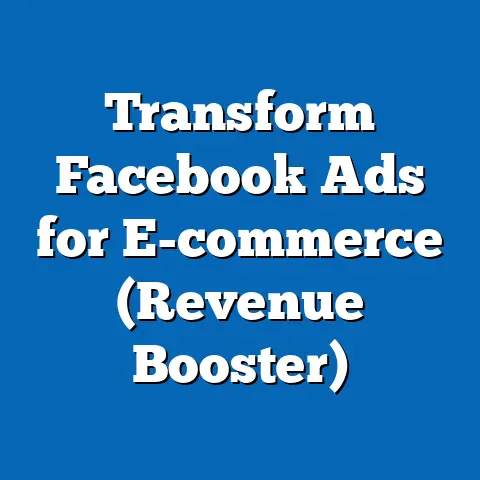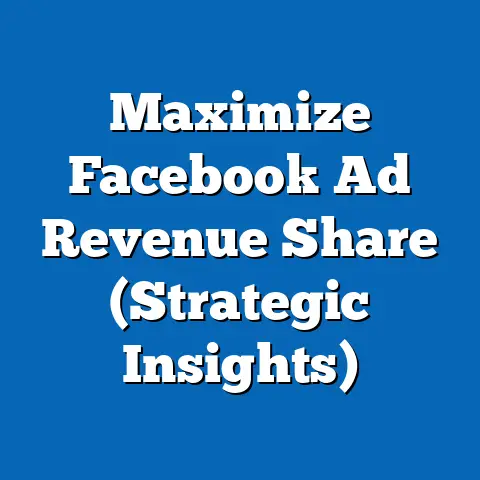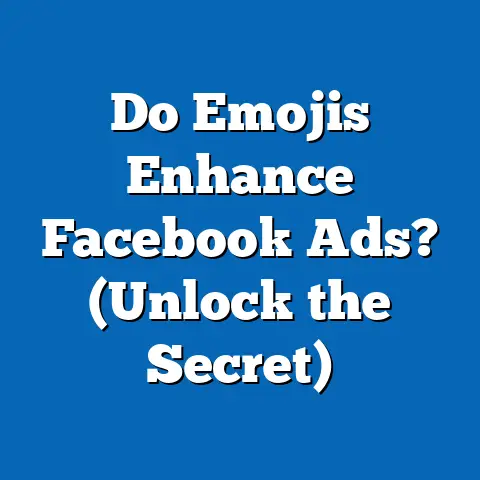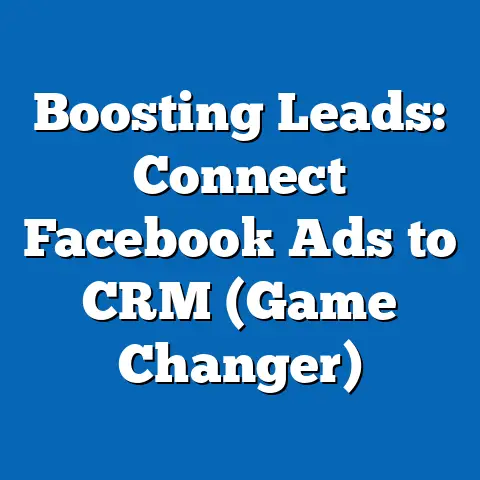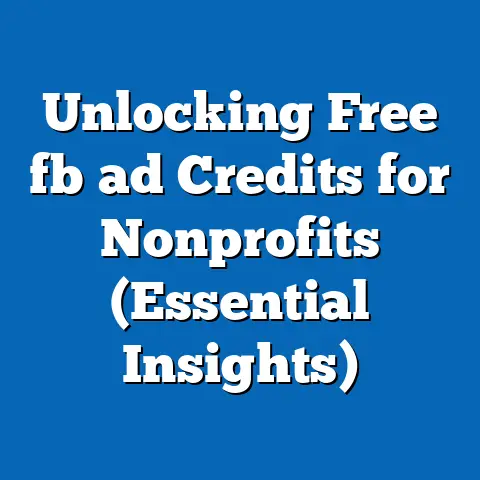Unlock Free Facebook Advertising Strategies (Pro Tips)
In today’s digital age, Facebook stands as a colossal platform, boasting billions of active users. It’s not just a social network; it’s a vibrant marketplace brimming with potential customers waiting to discover your brand. As a seasoned digital marketer, I’ve seen firsthand how Facebook has transformed from a simple social hub to a powerhouse advertising platform. The evolution has been incredible, and the opportunities it presents for businesses of all sizes are immense.
One common misconception I often encounter is that effective Facebook advertising requires a hefty budget. While paid ads can certainly amplify your reach, I’m here to tell you that you can achieve significant results with a zero-dollar budget. Yes, you read that right! With creativity, strategic thinking, and a bit of elbow grease, you can unlock the potential of Facebook advertising without spending a dime.
I’ve spent years experimenting with various strategies, both paid and organic, and I’ve discovered that some of the most impactful campaigns were built on ingenuity rather than a large budget. This guide is packed with pro tips I’ve gathered along the way, designed to help you craft effective Facebook advertising strategies that won’t break the bank.
What you’ll learn in this article:
- How to set up your Facebook Business Page for success.
- Strategies to leverage organic reach and beat the Facebook algorithm.
- Tactics to build a strong community and foster engagement.
- Ways to harness the power of content marketing for free advertising.
- How to track and analyze your performance to optimize your efforts.
So, whether you’re a startup founder, a small business owner, or a marketing enthusiast, this guide will equip you with the knowledge and tools you need to conquer Facebook advertising without a budget. Let’s dive in!
Section 1: Understanding the Facebook Advertising Landscape
Before we jump into the nitty-gritty of free strategies, let’s lay the groundwork by understanding the broader Facebook advertising landscape.
Overview of Facebook Ads
Facebook advertising has come a long way since its inception. Initially, it was a simple way for businesses to reach a wider audience, but over time, it has evolved into a sophisticated platform with advanced targeting options and diverse ad formats.
A Brief History:
- 2004: Facebook launches as a social networking site.
- 2007: Facebook introduces its first advertising platform, allowing businesses to create simple text-based ads.
- 2009: Facebook launches the “Like” button, revolutionizing social engagement and providing valuable data for advertisers.
- 2012: Facebook acquires Instagram, expanding its advertising reach and offering new opportunities for visual marketing.
- Present: Facebook (now Meta) continues to innovate, introducing features like AI-powered targeting, augmented reality ads, and immersive shopping experiences.
As Facebook’s advertising capabilities have grown, so has its relevance in the digital marketing world. According to Statista, Facebook’s advertising revenue reached nearly $115 billion in 2022, highlighting its significance as a primary channel for businesses to reach their target audience.
The Importance of Targeting
One of the most powerful aspects of Facebook advertising is its ability to target specific audiences based on a wealth of data. Unlike traditional advertising methods, Facebook allows you to reach people who are most likely to be interested in your products or services.
Targeting Options:
- Demographics: Target users based on age, gender, location, education, and more.
- Interests: Reach people who have expressed interest in specific topics, hobbies, or activities.
- Behaviors: Target users based on their online behavior, such as purchase history, device usage, and travel habits.
- Custom Audiences: Upload your own customer data (e.g., email lists, phone numbers) to create targeted audiences.
- Lookalike Audiences: Expand your reach by targeting users who are similar to your existing customers.
Understanding these targeting options is crucial for effective advertising, whether you’re running paid ads or leveraging free strategies. By focusing your efforts on the right audience, you can maximize your impact and achieve better results.
Free vs. Paid Advertising
While paid advertising on Facebook offers extensive reach and precise targeting, free advertising strategies can be equally effective in building brand awareness, driving engagement, and generating leads.
Benefits of Free Advertising:
- Cost-Effective: The most obvious benefit is that it doesn’t require a financial investment.
- Authenticity: Organic strategies often feel more authentic and less intrusive than paid ads.
- Community Building: Free methods like engaging in groups and creating valuable content can foster a strong sense of community around your brand.
- Long-Term Impact: While paid ads stop delivering results when you stop paying, organic strategies can have a lasting impact on your brand’s reputation and visibility.
When to Use Free Strategies:
- Startups and Small Businesses: When budget is limited, free strategies are a great way to get started.
- Building Brand Awareness: Organic methods are ideal for creating a positive brand image and increasing visibility.
- Engaging with Existing Customers: Free strategies can help you nurture relationships with your current customer base.
Takeaway: Understanding the Facebook advertising landscape and the power of targeting is essential for both free and paid strategies. Free advertising offers a cost-effective way to build brand awareness, engage with your audience, and drive results without a budget.
Section 2: Setting Up Your Facebook Business Page for Success
Your Facebook Business Page is the foundation of your advertising efforts. It’s where potential customers will learn about your brand, interact with your content, and ultimately decide whether to do business with you. Therefore, setting up your page for success is crucial.
Creating a Professional Business Profile
Think of your Facebook Business Page as your online storefront. It’s often the first impression potential customers will have of your brand, so it needs to be professional, informative, and engaging.
Key Elements of a Professional Profile:
- Profile Picture: Use a high-quality logo or a professional headshot that represents your brand.
- Cover Photo: Choose a visually appealing image that showcases your products, services, or brand personality.
- About Section: Write a concise and compelling description of your business, highlighting your unique value proposition.
- Contact Information: Include your website, email address, phone number, and physical address (if applicable).
- Call-to-Action Button: Add a button that encourages visitors to take a specific action, such as “Shop Now,” “Contact Us,” or “Learn More.”
Example:
Let’s say you run a local bakery called “Sweet Delights.” Your profile picture could be your bakery’s logo, and your cover photo could be a mouthwatering display of your signature pastries. In your “About” section, you could write: “Sweet Delights is a family-owned bakery serving fresh, delicious pastries made with love. Visit us for a taste of happiness!” Your call-to-action button could be “Order Now,” directing visitors to your online menu.
Crafting Engaging Content
Once your profile is set up, the next step is to populate it with engaging content that resonates with your audience. High-quality content is the key to attracting followers, driving engagement, and building a loyal community.
Types of Engaging Content:
- Visuals: Use high-quality photos and videos to capture attention and convey your message effectively.
- Videos: Create short, informative videos that showcase your products, services, or brand personality.
- Storytelling: Share stories that connect with your audience on an emotional level.
- Behind-the-Scenes: Give your followers a glimpse into the daily operations of your business.
- User-Generated Content: Encourage your followers to share their own content related to your brand.
Tips for Creating Engaging Content:
- Know Your Audience: Understand their interests, needs, and pain points.
- Be Authentic: Let your brand’s personality shine through.
- Provide Value: Offer informative, entertaining, or helpful content.
- Use a Consistent Brand Voice: Maintain a consistent tone and style across all your content.
- Encourage Interaction: Ask questions, run polls, and invite comments.
Utilizing Facebook Groups
Facebook Groups are a powerful tool for connecting with targeted audiences, fostering community engagement, and promoting brand loyalty. By creating or joining relevant groups, you can reach a highly engaged audience without spending a dime.
Creating Your Own Group:
- Choose a Niche: Focus on a specific topic or interest that aligns with your brand.
- Create a Welcoming Environment: Establish clear rules and guidelines for the group.
- Provide Value: Share informative content, answer questions, and facilitate discussions.
- Promote Your Brand (Subtly): Mention your products or services when relevant, but avoid being overly promotional.
Joining Existing Groups:
- Find Relevant Groups: Search for groups related to your industry, niche, or target audience.
- Engage Authentically: Participate in discussions, offer helpful advice, and build relationships.
- Share Your Expertise: Position yourself as a thought leader by sharing your knowledge and insights.
- Promote Your Brand (Strategically): Share links to your website or blog when relevant, but avoid spamming the group.
My Experience:
I once helped a local bookstore increase its visibility by creating a Facebook Group dedicated to book lovers in the area. The group quickly grew to over 1,000 members, and the bookstore saw a significant increase in foot traffic and online orders. The key was to provide value to the members by sharing book recommendations, hosting author Q&As, and facilitating discussions about literature.
Takeaway: Setting up a professional Facebook Business Page, crafting engaging content, and utilizing Facebook Groups are essential steps for successful free advertising. By focusing on these foundational elements, you can build a strong online presence and attract a loyal following.
Section 3: Leveraging Organic Reach
Organic reach refers to the number of unique users who see your content without you paying for distribution. It’s the holy grail of free Facebook advertising, and while it can be challenging to achieve, it’s definitely possible with the right strategies.
Understanding the Facebook Algorithm
The Facebook algorithm is a complex set of rules that determines which content users see in their News Feeds. It takes into account various factors, such as the type of content, the user’s past interactions, and the overall engagement level.
How the Algorithm Works:
- Relevance: Facebook prioritizes content that is relevant to each individual user.
- Engagement: Content that generates high levels of engagement (likes, comments, shares) is more likely to be shown to a wider audience.
- Recency: Newer content is generally given more weight than older content.
- Relationship: Facebook prioritizes content from friends and family over content from businesses.
Beating the Algorithm (Without Paying):
- Focus on High-Quality Content: Create content that is informative, entertaining, or inspiring.
- Encourage Engagement: Ask questions, run polls, and invite comments.
- Post at Optimal Times: Experiment with different posting times to see when your audience is most active.
- Use Visuals: Photos and videos tend to perform better than text-only posts.
- Stay Consistent: Post regularly to keep your audience engaged.
Content Strategies for Organic Growth
Creating compelling content is the key to driving organic growth on Facebook. Here are some specific content strategies that can help you increase your reach and engagement:
- Polls: Ask your followers for their opinions on a specific topic.
- Quizzes: Create fun and interactive quizzes that test your followers’ knowledge.
- User-Generated Content: Encourage your followers to share their own content related to your brand.
- Behind-the-Scenes: Give your followers a glimpse into the daily operations of your business.
- Live Videos: Host live Q&A sessions, product demos, or behind-the-scenes tours.
- Contests and Giveaways: Run contests and giveaways to incentivize engagement and attract new followers.
Example:
A local coffee shop could run a poll asking their followers to vote for their favorite seasonal drink. They could also create a quiz testing their followers’ knowledge of coffee brewing techniques. To encourage user-generated content, they could ask their followers to share photos of themselves enjoying their coffee at the shop.
Timing and Frequency of Posts
The timing and frequency of your posts can have a significant impact on your organic reach. Posting at the right time can ensure that your content is seen by more people, while posting too frequently can overwhelm your audience and lead to lower engagement.
Finding the Optimal Posting Times:
- Use Facebook Insights: Facebook Insights provides data on when your audience is most active.
- Experiment: Try posting at different times and track your results.
- Consider Your Audience: Think about when your target audience is most likely to be online.
Recommended Posting Schedule:
- Start with 1-2 Posts Per Day: This allows you to stay top-of-mind without overwhelming your audience.
- Adjust Based on Performance: If you’re seeing high engagement, you can increase your posting frequency. If you’re seeing low engagement, you may need to reduce it.
- Vary Your Content: Mix up your content types to keep your audience engaged.
Takeaway: Leveraging organic reach requires a deep understanding of the Facebook algorithm, a commitment to creating high-quality content, and a strategic approach to timing and frequency. By focusing on these elements, you can significantly increase your visibility on Facebook without spending a dime.
Section 4: Building a Strong Community
Building a strong community around your brand is essential for long-term success on Facebook. A loyal community will not only engage with your content but also advocate for your brand and drive word-of-mouth marketing.
Engagement Tactics
Engaging with your followers is crucial for building a strong community. By responding to comments, answering questions, and participating in discussions, you can show your followers that you value their input and build a deeper connection with them.
Effective Engagement Tactics:
- Respond to Comments Promptly: Acknowledge and respond to comments as quickly as possible.
- Ask Questions: Encourage discussions by asking open-ended questions.
- Run Polls and Quizzes: Engage your followers with interactive content.
- Host Q&A Sessions: Provide valuable information and answer your followers’ questions.
- Create a Sense of Belonging: Foster a welcoming and inclusive environment.
Example:
A fitness brand could respond to comments on their posts with personalized advice and encouragement. They could also ask questions like, “What are your fitness goals for this month?” To engage their followers, they could run polls asking about their favorite workout routines or host live Q&A sessions with fitness experts.
Collaboration and Networking
Collaborating with other brands and influencers can be a powerful way to extend your reach and enhance your credibility without incurring costs. By partnering with complementary businesses or influential figures in your industry, you can tap into their audience and gain exposure to a new group of potential customers.
Types of Collaboration:
- Cross-Promotion: Promote each other’s products or services on your respective pages.
- Guest Posting: Write guest posts for each other’s blogs or websites.
- Joint Webinars: Host joint webinars or online events.
- Influencer Marketing: Partner with influencers to promote your brand to their followers.
Finding Collaboration Partners:
- Identify Complementary Businesses: Look for businesses that offer products or services that complement your own.
- Research Influencers: Find influencers in your industry who have a strong following and a good reputation.
- Reach Out: Contact potential partners and propose a mutually beneficial collaboration.
Utilizing Facebook Live
Facebook Live is a powerful tool for connecting with your audience in real-time, building rapport, and promoting your products or services organically. By hosting live Q&A sessions, product demos, or behind-the-scenes tours, you can engage your followers in a more personal and interactive way.
Tips for Effective Facebook Live Sessions:
- Promote Your Live Session in Advance: Let your followers know when you’ll be going live.
- Choose an Engaging Topic: Select a topic that is relevant to your audience and that they will find interesting.
- Prepare Talking Points: Have a clear outline of what you want to cover.
- Interact with Your Audience: Respond to comments and answer questions in real-time.
- Promote Your Products or Services (Subtly): Mention your products or services when relevant, but avoid being overly promotional.
My Experience:
I once helped a local art gallery increase its visibility by hosting weekly Facebook Live sessions featuring local artists. The sessions were a huge hit, and the gallery saw a significant increase in online sales and foot traffic. The key was to create a fun and engaging atmosphere, showcase the artists’ work, and answer viewers’ questions in real-time.
Takeaway: Building a strong community requires consistent engagement, strategic collaboration, and effective use of Facebook Live. By focusing on these elements, you can create a loyal following that will support your brand and drive long-term success.
Section 5: Harnessing the Power of Content Marketing
Content marketing is a strategic approach to creating and distributing valuable, relevant, and consistent content to attract and retain a clearly defined audience — and, ultimately, to drive profitable customer action. On Facebook, content marketing can be a powerful way to attract followers, drive engagement, and promote your brand organically.
Creating Valuable Content
Types of Valuable Content:
- Educational Content: Teach your followers something new.
- Entertaining Content: Make your followers laugh or smile.
- Inspirational Content: Motivate your followers to achieve their goals.
- Helpful Content: Provide practical advice or solutions to their problems.
Example:
A cooking blog could create valuable content by sharing recipes, cooking tips, and tutorials. A travel blog could create valuable content by sharing travel guides, destination reviews, and packing tips. A personal finance blog could create valuable content by sharing budgeting tips, investment advice, and debt management strategies.
Repurposing Content
Repurposing content is a great way to maximize your reach and engagement without creating new content from scratch. By adapting existing content into different formats, you can reach a wider audience and cater to different learning styles.
Ways to Repurpose Content:
- Turn Blog Posts into Videos: Create short videos that summarize the key points of your blog posts.
- Turn Blog Posts into Infographics: Create visually appealing infographics that present data and information in an easy-to-understand format.
- Turn Blog Posts into Podcasts: Record audio versions of your blog posts and share them as podcasts.
- Turn Blog Posts into Social Media Posts: Extract key quotes and insights from your blog posts and share them on social media.
Example:
A marketing agency could turn a blog post about “5 Tips for Effective Social Media Marketing” into a video, an infographic, a podcast episode, and a series of social media posts. This would allow them to reach a wider audience and cater to different learning styles.
Using Facebook Stories
Facebook Stories are a great way to share quick, engaging content that disappears after 24 hours. They’re perfect for sharing promotions, behind-the-scenes content, and engaging your followers in a more casual setting.
Tips for Using Facebook Stories:
- Use Visuals: Photos and videos tend to perform well in Stories.
- Add Text Overlays: Use text overlays to highlight key points or provide context.
- Use Stickers and Filters: Add stickers and filters to make your Stories more engaging.
- Ask Questions: Use the “Question” sticker to gather feedback from your followers.
- Run Polls: Use the “Poll” sticker to engage your followers and gather their opinions.
- Promote Your Products or Services (Subtly): Mention your products or services when relevant, but avoid being overly promotional.
Example:
A clothing store could use Facebook Stories to showcase new arrivals, run flash sales, and give their followers a behind-the-scenes look at their operations. They could also use the “Question” sticker to ask their followers what types of clothing they’d like to see in the store.
Takeaway: Harnessing the power of content marketing requires a commitment to creating valuable content, a strategic approach to repurposing content, and effective use of Facebook Stories. By focusing on these elements, you can attract followers, drive engagement, and promote your brand organically.
Section 6: Tracking and Analyzing Performance
Tracking and analyzing your performance is essential for understanding what’s working and what’s not. By monitoring your key metrics and adjusting your strategies accordingly, you can maximize your impact and achieve better results.
Setting Goals and KPIs
Before you start tracking your performance, it’s important to set clear goals and key performance indicators (KPIs). Your goals should be specific, measurable, achievable, relevant, and time-bound (SMART). Your KPIs should be the metrics that you will use to measure your progress towards your goals.
Examples of SMART Goals:
- Increase Facebook Page Likes by 20% in the next 3 months.
- Increase Engagement Rate by 15% in the next 6 months.
- Generate 50 Leads from Facebook in the next month.
Examples of KPIs:
- Page Likes: The number of people who have liked your Facebook Page.
- Engagement Rate: The percentage of people who have interacted with your content (likes, comments, shares).
- Reach: The number of unique users who have seen your content.
- Website Traffic: The number of people who have clicked on links in your Facebook posts and visited your website.
- Leads: The number of people who have filled out a form or contacted you through Facebook.
- Sales: The number of sales that have been generated from Facebook.
Using Facebook Insights
Facebook Insights is a powerful tool that provides detailed data on your page’s performance. It allows you to track your key metrics, understand your audience demographics, and see which content is performing best.
Key Metrics to Track in Facebook Insights:
- Overview: Provides a summary of your page’s performance over the past week.
- Likes: Shows the number of new likes and unlikes your page has received.
- Reach: Shows the number of unique users who have seen your content.
- Engagement: Shows the number of likes, comments, shares, and clicks your content has received.
- Posts: Shows the performance of each individual post, including reach, engagement, and clicks.
- People: Provides demographic data on your audience, including age, gender, location, and interests.
How to Use Facebook Insights:
- Log in to your Facebook Page.
- Click on “Insights” in the left-hand menu.
- Explore the different sections to track your key metrics and understand your audience.
Adjusting Strategies Based on Data
The data you collect from Facebook Insights should be used to inform your strategies and make adjustments as needed. If you’re seeing low engagement on a particular type of content, try experimenting with different formats or topics. If you’re not reaching your target audience, try adjusting your targeting options.
Example:
If you’re running a Facebook Page for a local restaurant and you’re seeing low engagement on your posts about your menu items, you could try posting more visually appealing photos of your dishes, running polls asking your followers what their favorite menu items are, or hosting live Q&A sessions with your chef.
Takeaway: Tracking and analyzing your performance is essential for maximizing your impact on Facebook. By setting clear goals, monitoring your key metrics, and adjusting your strategies based on data, you can achieve better results and grow your brand organically.
Conclusion: Embracing Creativity and Persistence
Unlocking the full potential of Facebook advertising without a budget requires a blend of creativity, persistence, and a deep understanding of the platform. It’s about thinking outside the box, leveraging the resources available to you, and consistently engaging with your audience.
Remember, Facebook is more than just a social network; it’s a community. By building meaningful connections with your followers, providing valuable content, and fostering a sense of belonging, you can create a loyal following that will support your brand and drive long-term success.
Key Takeaways:
- Set up your Facebook Business Page for success: Create a professional profile, craft engaging content, and utilize Facebook Groups.
- Leverage organic reach: Understand the Facebook algorithm, create compelling content, and post at optimal times.
- Build a strong community: Engage with your followers, collaborate with other brands, and utilize Facebook Live.
- Harness the power of content marketing: Create valuable content, repurpose existing content, and use Facebook Stories.
- Track and analyze performance: Set clear goals, monitor your key metrics, and adjust your strategies based on data.
Final Thoughts:
Don’t be afraid to experiment with different strategies and see what works best for your brand. The key is to be patient, persistent, and always willing to learn. With dedication and a bit of creativity, you can achieve remarkable growth and success on Facebook without spending a fortune. So, embrace these pro tips, put them into action, and unlock the full potential of your Facebook advertising efforts. Good luck!

